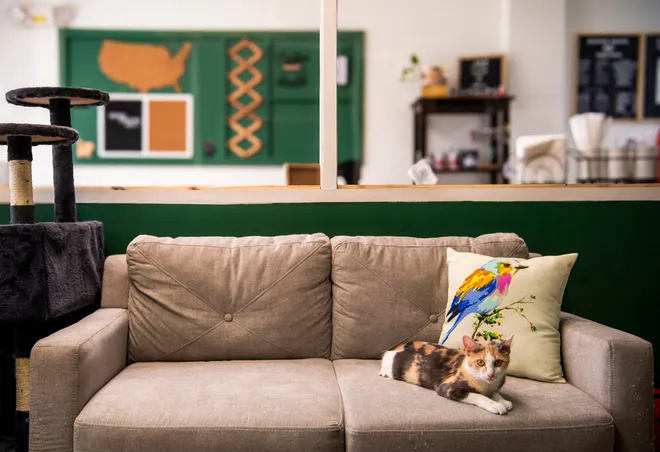Cheetos fingers and red wine spills are ruining couches. How to cushion your investment.
Two years ago, Alexis Sullivan woke on Christmas morning to find a gaping hole in her couch courtesy of her 10-year-old pitbull terrier, Jax. With a quick trip to JoAnn Fabrics for $15 in some fabric and spray adhesive, she came up with a clever fix that allowed the family to get another year out of the couch.
The Massachusetts-based content creator and mother of three is not alone in her sofa struggles. In households across the nation, no upholstery is safe from mishaps – be it kid chaos, playful pets or pizza night in front of the TV.
Nearly 175 million Americans have damaged a piece of furniture and 61% of accidents occurred in the first two years of ownership, according to a new survey from Allstate Protection Plans. When asked which piece of furniture was most recently damaged or stained, 40% of Americans said sofas, couches and loveseats.
Kids are often the culprits, but the Allstate survey uncovered a surprising finding: The worst offenders are adults. Juice boxes, permanent markers and dog vomit have nothing on red wine spills during a party or take-out tumbling from plates perched on laps during Netflix binges.

Forty-five percent of adults blame their spouses for furniture damage while 34% blame their kids. Dogs were the reigning scamps in most households and were twice as likely as cats to cause damage.
Repairing or replacing furniture is expensive
Some 43% of people tried to fix the damage themselves, while 38% kept using their furniture despite the damage, 23% said they hid or covered up the damage, 14% replaced the furniture and just 4% repaired it, Allstate found.
Repairing the damage or replacing damaged furniture isn’t cheap. Americans spent $299 on average.
Mackenzie Eddie, a mother of three and a marketing and brand strategy professional in Iowa, says her couch and loveseat are the main targets of stains and spills in her household, from Saturday morning coffee spills to juice boxes smuggled into the living room despite the no food or drink around the furniture rule.
“A particularly devastating stain happened when our middle child, who was around 18 months old, was playing with two bottles of my nail polish and smashed them together, breaking one,” Eddie said. “If I remember correctly, it was a dark red color that spilled all over the sofa.”
The couch couldn't be salvaged so the same day, she ran out and bought a new one.

A couple of years ago, the family moved into a new home. Eddie says the furniture looked pristine for about two weeks.
“Then the stains started popping up, whether from orange Cheetos fingers, a bloody knee or the infamous applesauce packets,” she said. “The furniture has ‘held up’ to the point of still being in our living room, but it definitely doesn't look as nice as the day we moved it in. Looking back, I regret not getting furniture coverings to protect it better, but that's something I'll definitely consider in the future.”
Some homeowners buy white couches, others play it safe
Thirty-eight percent of Americans have covered furniture with towels or sheets to protect it, 29% have used slipcovers and plastic covers, 20% have used treatments to prevent stains and 22% have a protection plan or extended warranty, according to Allstate.
So great is the fear of damage that more than a third of Americans said they avoid buying high-end furniture.
Resh Susan, a freelance writer and editor based in India, said when it came to picking out a sofa, she played it safe. Black, leather and low maintenance.
While she loves the look of white couches, she says she would never dare own one herself. What if she spills coffee or food on it and the stain won’t come out? What if a guest’s baby wipes sticky fingers on the fabric?

“It's just too stressful,” she said. “If there is a stain and it doesn't go away, then it just ruins the whole look.”
Not Sullivan. She’s used to chaos. The bio on her TikTok account is “turning my house into a home while my kids trash it.”
One year ago, she replaced her torn-up couch with a new white one. Sullivan said it was a risk she was willing to take.
“I could’ve gotten blue or gray, but it wouldn’t have matched my mauve walls,” she said.
Sullivan, who posts her DIY home projects online, protects the new furniture from wear and tear by stocking up on her favorite stain remover and warning her kids to keep messy food away from the furniture.
With three kids under the age of 5, said she knows the white couch won’t stay white for long.
“(My kids) just got slime on it the other day,” she said. This time, she was able to salvage the sofa cover by tossing it in the washing machine. But, she concedes, “I think you can only prevent it for so long.”
How to make your furniture last
Christophe Pourny, an antique furniture restorer and author of “The Furniture Bible: Everything You Need to Know to Identify, Restore and Care for Furniture,” recommends a few tricks for making furniture last.
Cleaning furniture regularly is “essential.” Not only is it good for its longevity, since dust and dirt can leave marks, but it’ll allow you to regularly examine your furniture for any sort of damage. Pourny recommends dry dusting for most cleans to avoid products that could build up oil and dust, and suggests taking care of any stains, holes and discoloration immediately. “The more you let things go,” he said, “the more it’s going to evolve into something really serious.”
- Watch for sun damage, which can cause fabric or wood to fade, he says.
- Control environmental factors. Too much humidity can cause furniture to swell or get musty, while a too-dry environment can make wood furniture crack, according to Pourny.
- Be gentle with your furniture. Pourny warned against keeping your drawers open, which can weigh down on its hinges, and putting too much pressure on the slides by overfilling drawers.
- Use coasters and mats: They can prevent rings and stains from moisture and heat, Allstate says.
- Invest in protective covers: For both indoor and outdoor furniture, especially high-use pieces, covers can help, Allstate recommends. Mattress protectors are also a good idea.
- Rotate and rearrange: Rotate cushions periodically to distribute weight and wear.
Disclaimer: The copyright of this article belongs to the original author. Reposting this article is solely for the purpose of information dissemination and does not constitute any investment advice. If there is any infringement, please contact us immediately. We will make corrections or deletions as necessary. Thank you.







